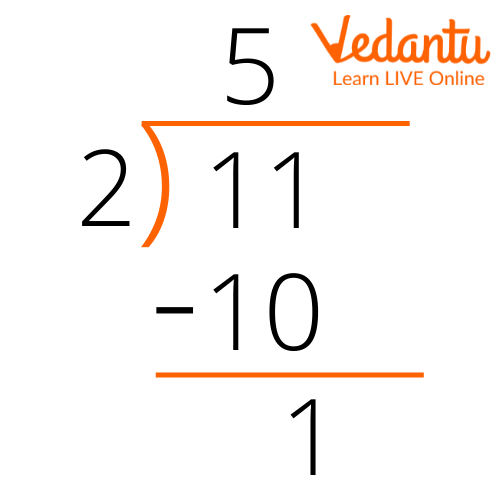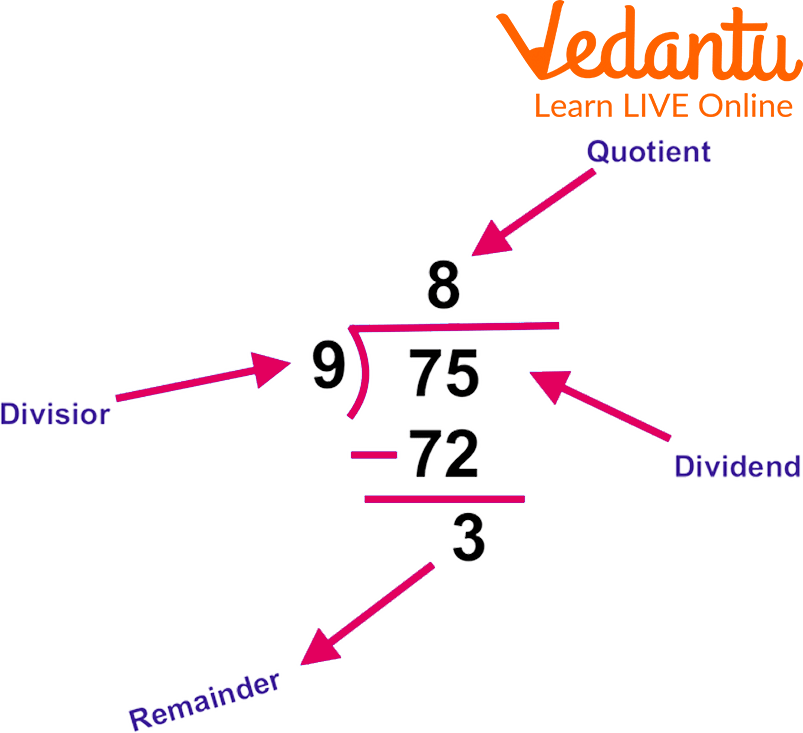




How to Apply Divisor, Dividend, Quotient, and Remainder in Problems
The dividend-quotient formula shows the relationship between the dividend, the divisor, the quotient and the remainder, which is one of the main aspects of division. Division is the process of dividing a number into equal parts, leaving a remainder if the number cannot be further divided. The quotient formula of the remainder of division is an important rule in division. Let us learn more about these concepts ahead!

Parts of a Division
What Is the Divisor Dividend Quotient Remainder?
Divisor
A divisor is a number that divides the other number in the calculation. The divisor definition states that it is the term performing the division operation on the dividend. For example, when we divide the number 28 by the number 7, 7 is called the divisor, whereas the number 28 is called the dividend.
The formula for Divisor = (Dividend - remainder) ÷ Quotient
Dividend
A dividend is a whole number or the number of things that need to be divided into certain equal parts. Dividend is the number that is to be divided by the divisor.
The formula for Dividend = Divisor x Quotient + Remainder
Quotient
When you divide two numbers, the result of their division, called a quotient, will be a whole number. If the two numbers have no remainder when divided, they are called "perfect" factors and their quotient is their "product".
The formula for Quotient = Dividend ÷ Divisor.
Remainder
In Mathematics, the remainder is the amount "left over" after performing some computation. In arithmetic, the remainder is the integer "left over" after dividing one integer by another to produce an integer quotient.
The formula for Remainder = dividend - (divisor × quotient)
For example, 75 divided by 9 gives 8 as a quotient and 3 as a remainder.

Divisor Dividend Quotient and Remainder
Where Are Dividend, Divisor, Quotient and Remainder Used in Maths?
The divisor is used in the decimal system to convert a decimal number into fractions. The quotient is used in the multiplication of two whole numbers: for example, 4×5=20, which was simplified from $4 \times 5=20\Rightarrow \dfrac{(4 \times 10)}{2}$.
Solved Examples
Q 1 Divide 217 by 4.
Ans: $\dfrac{217}{4}$
Here, Dividend = 217
Divisor = 4
Quotient = 54
Remainder = 1
Q 2 Find the remainder when the dividend is 75, the divisor is 5 and the quotient is 15.
Ans: Given, dividend = 75, divisor = 5, quotient = 15 and let the remainder be x
75 = 5 × 15 + x
75 = 75 + x
x = 75 - 75
x = 0
Therefore, by using the formula we obtained the remainder which is 0. Remainder = 0
Q 3 Find the remainder when the dividend is 63, the divisor is 2 and the quotient is 31.
Ans: Given, dividend = 63, divisor = 2, quotient = 31 and let the remainder be x
63 = 2 × 31 + x
63 = 62 + x
x = 63 - 62
x = 1
Q 4 Divide 5679 by 7.
Ans: $\dfrac{5679}{7}$
Here, Dividend = 5679
Divisor = 7
Quotient = 811
Remainder = 2
Q 5 Find the remainder when the dividend is 57, the divisor is 8 and the quotient is 7.
Ans: Given, dividend = 75, divisor = 5, quotient = 15 and let the remainder be x
57 = 8 × 7 + x
57 = 56 + x
x = 57 -56
x = 1
Therefore, by using the formula we obtained the remainder which is 1. Remainder =1
Practice Questions
Q 1 Divide 120 by 5 and find the quotient and the remainder.
Ans: Quotient = 24
Remainder = 0
Q 2 Find the dividend when the remainder is 1, the divisor is 3, and the quotient is 31.
Ans: Dividend = 94
Q 3 Find the remainder when the dividend is 55, the divisor is 3 and the quotient is 18.
Ans: Remainder = 1
Summary
In conclusion, the number which is getting divided here is called the dividend. The number which divides a given number is the divisor. Also, the number which we get as a result is known as the quotient. The divisor which does not divide a number completely produces a number, which is referred to as remainder. We now hope you have a clear understanding of divisor, dividend, quotient and remainder.
FAQs on Divisor, Dividend, Quotient, and Remainder Made Easy
1. What is the formula for divisor dividend quotient and remainder?
The standard formula relating divisor, dividend, quotient, and remainder in division is:
$$ \text{Dividend} = (\text{Divisor} \times \text{Quotient}) + \text{Remainder} $$
This formula helps you check the correctness of division problems. In every division situation:
- Dividend: The number that is being divided
- Divisor: The number by which the dividend is divided
- Quotient: The result of the division (how many times the divisor fits into the dividend)
- Remainder: The part left over after division, if the dividend is not exactly divisible by the divisor
2. What are the 4 terms of division?
Division involves four primary terms:
- Dividend: The number that is being divided
- Divisor: The number by which the dividend is divided
- Quotient: The result of the division, i.e., how many times the divisor fits into the dividend
- Remainder: The part of the dividend that remains after whole number division
3. How to find the divisor given the dividend quotient and remainder?
If you know the dividend, quotient, and remainder, you can find the divisor using the division formula:
$$ \text{Dividend} = (\text{Divisor} \times \text{Quotient}) + \text{Remainder} $$
Rearrange to isolate the divisor:
$$ \text{Divisor} = \frac{\text{Dividend} - \text{Remainder}}{\text{Quotient}} $$
For example, if the dividend is 47, quotient is 6, and remainder is 5:
$$ \text{Divisor} = \frac{47 - 5}{6} = \frac{42}{6} = 7 $$
Vedantu's math experts explain and practice these calculations with interactive sessions and worksheets for better clarity.
4. How to identify dividend and divisor?
To identify the dividend and divisor in a division problem, remember:
- Dividend: The number that is being divided; it is usually written first in the division expression.
- Divisor: The number by which the dividend is divided; it follows the dividend in the division expression.
- 20 is the dividend
- 4 is the divisor
5. What is the difference between quotient and remainder in division?
Quotient and remainder are two distinct outcomes of a division operation:
- Quotient: The number of times the divisor fits completely into the dividend. It is an integer value representing the main result of division.
- Remainder: The portion of the dividend left after dividing by the divisor, provided the division is not exact.
6. Can the remainder ever be greater than the divisor?
No, in a division problem, the remainder is always less than the divisor. If the remainder were equal to or greater than the divisor, it means the division was not complete, and further division could occur. For example, when dividing 22 by 5, the quotient is 4 and the remainder is 2 ($22 = 5 \times 4 + 2$), since 2 < 5. This foundational rule is emphasized and practiced in Vedantu's division lessons for better conceptual understanding.
7. What are some practical examples of divisor, dividend, quotient and remainder in daily life?
Examples of division terms in everyday situations:
- Sharing 25 apples among 4 friends: 25 is the dividend, 4 is the divisor. Each friend gets 6 apples (quotient), and 1 apple is left (remainder).
- Packing 37 books into boxes of 8: 37 books (dividend), boxes hold 8 books each (divisor). You fill 4 boxes (quotient), with 5 books remaining (remainder).
8. How are division terms used in word problems and exams?
In math word problems and exams, division terms like dividend, divisor, quotient, and remainder help students break down and solve problems step by step. Students are often asked to identify these terms, set up corresponding equations, and use the formula $\text{Dividend} = (\text{Divisor} \times \text{Quotient}) + \text{Remainder}$. Vedantu provides a range of word problems and practice tests that help students master these concepts in preparation for school and competitive exams.
9. Why is understanding the divisor, dividend, quotient and remainder important in mathematics?
A clear understanding of divisor, dividend, quotient, and remainder forms the basis for division and is foundational for solving advanced mathematical topics such as fractions, algebra, and number theory. Mastery of these concepts ensures success in mathematical reasoning, problem-solving, and standardized tests. Vedantu's courses give focused attention to these basics through visual explanations and interactive exercises designed by expert teachers.

















